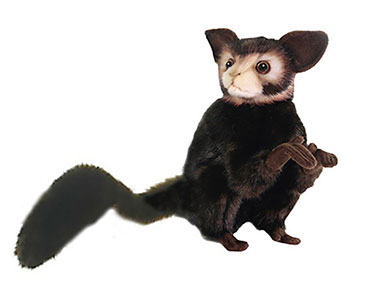Aye Aye Lemur Plush Toys
Find Aye Aye Lemur stuffed animals, facts and information in the Zoo at Animals N More.
Find lemur stuffed animals in the Jeannie's Cottage Gift Shop. Jeannie's Cottage LLC is our sponsor. The plush toy Aye Aye shown above is made by Hansa.
The Aye-aye, Daubentonia madagascariensis,
is a creature of Madagascar; it is like the lemurs, but because of its specialized traits and differences from other primates, the aye-aye is included in its own family, genus and species. The taxonomy of this animal is difficult to determine due to its odd conglomeration of traits. It has two pairs of chisel-like gnawing front teeth very much like a rodent's.
The aye-aye is about the size of a house cat. It has coarse, shaggy dark brown hair, and a very long bushy tail. Its hands are long and its clawed fingers thin and spider-like. Longest and thinnest of all is the middle finger, which moves independently from the other digits. It is said that the animal feeds on tree-boring insects and uses its chisel teeth to cut through the wood; with the claw on the thin middle finger it reaches into the cracks and hook out the insect larvae. It uses this finger for tapping on the branch of a tree; by listening to the sound the aye-aye is able to determine just where a boring bug is located. In addition to insects, aye-ayes also eat seeds, nectar and fungus. They can be considered omnivores whose food choice varies with habitat type and food availability
The aye-aye also uses its all-purpose middle finger to comb its hair, and clean its face, nose, mouth, and huge, leathery ears. It also employs it to bring water to its mouth: the animal will sweep the finger from the water source to its lips a good forty times a minute.
In its broad face this strange creature has big eyes that help it to see its way in the bamboo forests as it prowls solitarily under cover of darkness. Here its opposable great toe (a feature it shares with the lemurs) helps it to maintain its hold.
All day the aye-aye sleeps high in the trees with its single young. Its nest is made of dry leaves and twigs, and is shaped like a ball, about two feet through, with an entrance at the side. Each aye-aye has several nests. The Malagasy, who believe that touching an aye-aye means death, nevertheless say that a twig from this nest will bring good fortune. Due to their superstitions, some people will kill an aye-aye on sight.
The aye-aye can live up to 24 years in captivity. Its conservation status is "near threatened."
Order: Primates | Suborder: Strepsirrhini | Family: Daubentoniidae
Genus: Daubentonia | Species: D. madagascariensis





